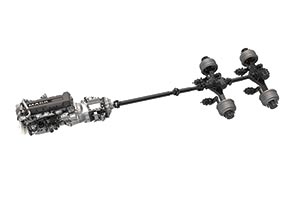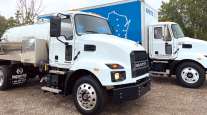Mack Unveils 2017 Powertrain

 Mack Trucks
Mack TrucksAUSTIN, Texas — Mack Trucks presented a new powertrain that it said was designed to meet the second stage of Phase 1 federal greenhouse-gas limits. Those limits tighten the maximum legal amount of carbon dioxide output from a truck starting in January.
The rollout of the 2017 powertrain, occurring on Earth Day, included new technologies for its MP7 and MP8 engines.
Mack President Dennis Slagle and other company executives at the April 22 event stressed 5% engine efficiency improvement by 2017, over 2014 engines, as an enticement for truck buyers. But he added that Mack personnel are monitoring what will happen with the fast-approaching Phase 2 of greenhouse-gas developments, including meetings with top Environmental Protection Agency officials.
EPA and the National Highway Traffic Safety Administration published a Phase 2 proposal in June 2015, and a final version is expected in August. The rule will further tighten carbon dioxide maximums from heavy- and medium-duty trucks through 2027, as a follow-up to Phase 1, which started in 2014.
Asked about a report from ACT Research Co. that Phase 2 could cause another pre-buy situation, where truck sales boom in 2019 and 2020 and then crater in 2021, Slagle said it is more than a hypothetical situation.
“I understand the logic behind [the ACT forecast]. This needs to be addressed,” he told editors and reporters at the event.
Slagle said EPA officials understand the problems caused by a pre-buy and don’t want a repeat of the 2005-2006 selling spree, followed by a 2007-2008 bust. He said labor unions have told the Obama administration that the January 2007 regulatory change led to significant decreases in factory employment.
Further, if California tightens regulations beyond EPA standards, it could make matters worse, Slagle said.
“They don’t want this,” Slagle said of EPA’s preferences concerning a supplementary rule from California.
The California Air Resources Board is concerned about carbon dioxide and nitrogen-oxide compounds, and has said it might publish another rule that would tighten nitrogen-oxide standards in California during the same time Phase 2 of greenhouse gases is being implemented.
Truck and engine makers have warned of the extreme difficulty of complying simultaneously with both mandates.
All heavy-duty engine makers have to improve fuel efficiency and decrease carbon dioxide and other GHG emissions by at least 3% starting in January, and Mack said its new features should increase MP7 engine efficiency by up to 5.1%, and by up to 5% for the MP8 engine.
The MP7 engine has 11 liters of displacement, and the MP8 has 13 liters.
Similar engine technologies recently were unveiled by Volvo Trucks North America, a sister company to Mack within Volvo Group.
The Mack event was the same day that Volvo Group reported first- quarter earnings. Slagle repeated the corporation’s new estimate that new North American heavy-duty truck registrations would be 250,000 vehicles this year, down from an early forecast of 260,000. Registrations in 2015 were 301,700.
Despite the lowered forecast, Volvo Group is not panicking, Slagle said.
“Since September, all OEMs have been in correction mode, draining out inventory. We’re making progress, but there’s still too much inventory,” he said. “This isn’t [severely troubled] Brazil. We still have 2% to 2.5% annual growth,” in the United States.
An unplayed ace for Mack is the FAST Act, the federal highway law enacted in December that funds five years of nationwide road building. Vocational vehicles such as dump trucks and concrete mixers are a big part of Mack’s sales, and Slagle said he has been talking to customers in the construction business about the law.
Comparing sales from this January and February with the same time in 2015, Slagle said vocational trucks are moving better for Mack, but he refrained from linking that solely to the FAST Act.
“I think the law has brightened the outlook for sales, but there’s no real money from it yet,” he said.
The history of the pre-buy from a decade ago is that U.S. fleets bought heavy-duty trucks at an accelerated pace in 2005 and 2006, with many purchasers saying they wanted to avoid the first trucks made with 2007 technology mandated by EPA to control nitrogen oxide and particulate matter emissions. Those vehicles were the first to use diesel particulate filters, and had a second generation of exhaust gas recirculation. That boom was followed by a sales bust.
EPA has switched its regulatory emphasis from nitrogen oxide and particulates to concentrating on carbon dioxide and other GHGs. Phase 1 of the federal effort will be fully implemented as of Jan. 1.




